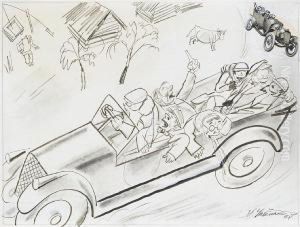Aleksei Aleksandrovich Uspensky Paintings
Aleksei Aleksandrovich Uspensky was a Russian artist and graphic designer born on October 17, 1900, in the city of Tula, Russian Empire. He grew up during a time of significant political and social upheaval, which was reflected in the changing styles and themes of Russian art. As a young man, Uspensky showed a keen interest in the arts and attended the Moscow School of Painting, Sculpture and Architecture, where he was a contemporary of other future Russian artists and was influenced by the avant-garde movements of the time.
Uspensky's work was marked by its diversity and innovation. He was involved in various fields, including graphic design, illustration, and poster art. His style evolved over the years, showing elements of Futurism, Constructivism, and later Socialist Realism. During the 1920s and 1930s, he became well-known for his propaganda posters, which supported the Soviet Union's industrialization and collectivization campaigns. His artwork often featured bold colors, geometric shapes, and a strong sense of composition, which helped convey powerful political messages.
Despite his success as an artist, Aleksei Uspensky's life was cut short by the political purges of the late 1930s. He was arrested in 1938 during the Great Purge under Joseph Stalin's regime. Accused of participating in counter-revolutionary activities, he was executed on February 2, 1940. His work was largely forgotten in the subsequent decades, overshadowed by the repressive climate of the time. It was not until the late 20th century that Uspensky's contributions to Russian art and graphic design began to be re-evaluated and appreciated once again, allowing him to take his place among the notable artists of the Soviet era.


